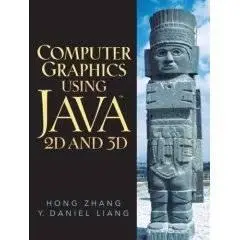One of the authors has written several books on Java that were very good, so I was expecting something more than I have been seeing with academic-oriented computer graphics textbooks. So far, I have been quite pleased. The book does a good job of combining the teaching of computer graphics principles with enough of the fundamentals of programming in the Java 2D and Java 3D APIs to make the reader competent in being able to transfer his/her knowledge to other graphics APIs. However, there is just enough of the Java graphical APIs shown to establish basic competency in programming with them, so if what you are really seeking is great ability in Java 2D or Java 3D you should look for other sources of information. There are lots of Java programs demonstrating graphics principles included, just not a detailed explanation of the APIs involved. The only chapter that is a little off is the last one on additional 3D topics. I'm not sure why a section on sound was included in a text on graphics, other than because Java 3D has a sound engine, although it has always proved somewhat unreliable. The table of contents is as follows:
Chapter 1. Overview of Computer Graphics
1.1 Introduction
1.2 Computer Graphics Systems and Related Fields
1.3 Java Programming Language
1.4 Java 2D and Java 3D
Chapter 2. 2D Graphics: Basics
2.1 Introduction
2.1 Introduction
2.2 2D Rendering Process
2.3 2D Geometry and Coordinate Systems
2.4 The Graphics2D Class
2.5 Graphing Equations
2.6 Geometric Models
2.7 Constructive Area Geometry
2.8 General Path
Chapter 3. 2D Graphics: Rendering Details
3.1 Introduction
3.2 Colors and Paints
3.3 Strokes
3.4 Affine Transformation
3.5 Compositions of Transformations
3.6 Transparency and Compositing Rules
3.7 Clipping
3.8 Text and Font
Chapter 4. 2D Graphics: Advanced Topics
4.1 Introduction
4.2 Spline Curves
4.3 Custom Primitives
4.4 Image Processing
4.5 Creating Fractal Images
4.6 Animation
4.7 Printing
Chapter 5. Basic 3D Graphics
5.1 Introduction
5.2 3D Rendering Process
5.3 Java 3D API Overview
5.4 Java 3D Scene Graphs
5.5 The Superstructure
5.6 The Nodes
5.7 The Node Components
5.8 The Structure of a Java 3D Program
5.9 Backgrounds and Bounds
5.10 Compiling Scene Graphs and Capacity Bits
Chapter 6. Graphics Contents
6.1 Introduction
6.2 Points and Vectors
6.3 Geometry
6.4 GeometryInfo
6.5 Primitives
6.6 Fonts and Texts
6.7 Appearance and Attributes
Chapter 7. Geometric Transformation
7.1 Introduction
7.2 3D Affine Transformations
7.3 Transformations in Scene Graphs
7.4 Composite Transforms
7.5 Constructing Geometries with Transformations
Chapter 8. Views
8.1 Introduction
8.2 Projections
8.3 Specification of a View
8.4 Java 3D View Model
8.5 Picking
8.6 Head Tracking
Chapter 9. Lighting and Texturing
9.1 Introduction
9.2 Lights
9.3 Illumination Models
9.4 Material
9.5 Atmospheric Attenuation and Depth Cueing
9.6 Texture Mapping
9.7 Texture Coordinates Generation
Chapter 10. Behavior and Interaction
10.1 Introduction
10.2 Behavior
10.3 Interaction
10.4 Behavior and Picking
Chapter 11. Animation
11.1 Introduction
11.2 Alpha Objects
11.3 Interpolators
11.4 Morphing
11.5 LOD
11.6 Billboard
Chapter 12. Additional 3D Topics
12.1 Introduction
12.2 3D Curves
12.3 Surfaces
12.4 Sound
12.5 Shadows
12.6 Geometry Change
12.7 Off Screen Rendering
12.8 3D Textures



